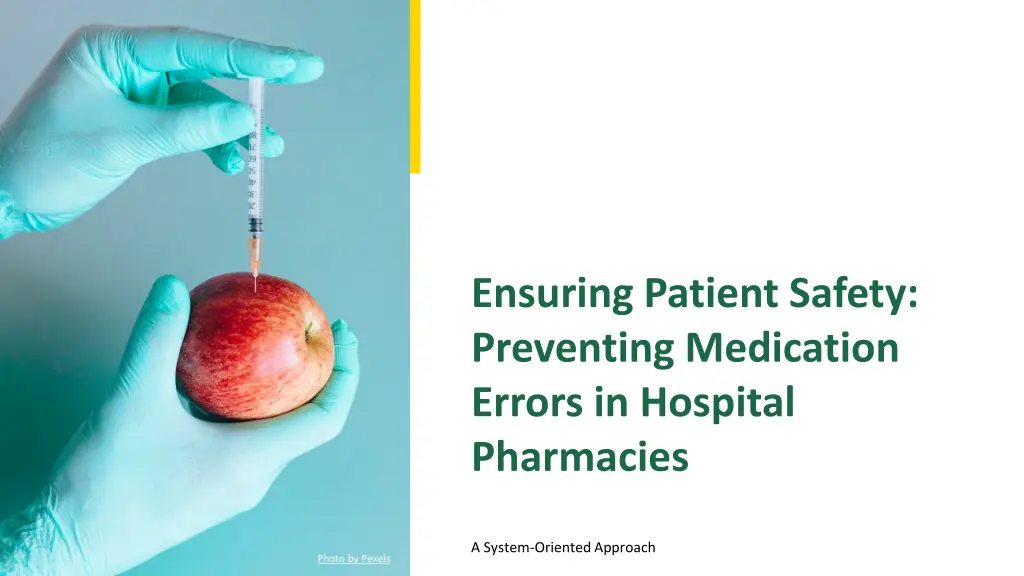
Preventing Medication Errors in Hospital Pharmacies: A Comprehensive Guide
Learn how to prevent medication errors in hospital pharmacies through a system-oriented approach. Understand the root causes of errors, implement training and education programs, standardize processes, utilize technology, and engage patients for better outcomes.
Download Presentation

Please find below an Image/Link to download the presentation.
The content on the website is provided AS IS for your information and personal use only. It may not be sold, licensed, or shared on other websites without obtaining consent from the author. If you encounter any issues during the download, it is possible that the publisher has removed the file from their server.
You are allowed to download the files provided on this website for personal or commercial use, subject to the condition that they are used lawfully. All files are the property of their respective owners.
The content on the website is provided AS IS for your information and personal use only. It may not be sold, licensed, or shared on other websites without obtaining consent from the author.
E N D
Presentation Transcript
Ensuring Patient Safety: Preventing Medication Errors in Hospital Pharmacies A System-Oriented Approach Photo by Pexels
01 Understanding Medication Errors Table of Contents 02 Root Causes of Errors 03 The System-Oriented Approach 04 Training and Education 05 Standardization of Processes 06 Utilizing Technology 07 Reporting and Analyzing Errors 08 Engaging Patients in Safety 09 Evaluating Outcomes 10 Thank You!
1 Understanding Medication Errors A Critical Concern Medication errors significantly impact patient safety and healthcare quality globally, presenting a critical concern for hospital pharmacies. These errors can result in serious harm, increased hospital stays, and additional healthcare costs, ultimately affecting patientoutcomes. Recognizing the various types of medication errors is the first step towards their prevention, fostering a safer healthcare environment. Awareness is key in addressing this pressing issue and ensuring the well-being of patients in our care. Photo by Pexels
2 Root Causes of Errors Identifying the Issues Understanding the root causes of medication errors helps in developing effective preventionstrategies. Common causes include communication failures, lack of standardization, and insufficient training among healthcare professionals. Identifying these issues allows hospital pharmacies to implement targetedinterventions to minimize risk factors. By assessing workflows and processes, pharmacies can expose vulnerabilities susceptible to error. Photo by Pexels
3 The System-Oriented Approach Changing the Perspective Adopting a system-oriented approach shifts focus from individual blame to addressing systemic flaws that contribute to errors. This perspective promotes collective responsibility among healthcare teams, emphasizing collaboration and communication. Implementing systems tools such as checklists and electronic prescribingcan enhance accuracy and reduce risks. Creating a culture of safety ensures continuous improvement in medication management processes. Photo by Pexels
4 Training and Education Empowering Staff Training programs are crucial in empowering pharmacy staff to recognize potentialerrors and respondeffectively. Continuous education fosters a culture of learning, equipping professionals with current knowledge and skills. Workshops and simulations provide hands-on experiences that help reinforce best practices in medication administration. Empowered staff are more confident and capable, resulting in enhanced patientsafety. Photo by Pexels
5 Standardization of Processes Creating Consistency Standardizing medication dispensing processes minimizes variability and the potential for errors. Clear protocols should be established to guide pharmacy operations, ensuringevery step is carefully followed. Emphasizing uniformity in medication storage and labeling furtherreduces confusion and error risks. A consistent approach enhances reliability and fosters a safer environmentfor patientcare. Photo by Pexels
6 Utilizing Technology A Modern Solution Technological advancements play a significant role in reducing medication errors in hospital pharmacies. Electronic health records (EHR) and computer-assisted dispensing systems streamline medication management. Implementing barcoding systems ensures accurate medication administration at the point of care. Leveraging technology enhances communication, accuracy, and efficiency in pharmacy operations. Photo by Pexels
7 Reporting and Analyzing Errors Learning from Mistakes Establishing a non-punitive error reporting system encourages staff to report errors without fear of retribution. Analyzing reported errors provides insights into recurring issues or systemic flaws that need addressing. This ongoing process allows pharmacies to refine strategies and evolve their practices continuously. Learning from mistakes fosters a proactive culture, prioritizing patientsafety. Photo by Pexels
8 Engaging Patients in Safety A Shared Responsibility Involving patients in their medication management empowers them to take an active role in their healthcare. Educating patients on their medications increases awareness and encourages them to ask questions. A collaborative approach between healthcare providers and patients fosters trust and communication. Patient engagement is a crucial element in reducing medication errors. Photo by Pexels
9 Evaluating Outcomes Measuring Success Regularly evaluating the outcomes of implemented strategies is essential for determining their effectiveness. Using key performance indicators (KPIs) helps in assessing the reduction of medication errors over time. Adapting strategies based on evaluation results ensures continued improvement and safety. Success is measurable, and ongoing assessments contribute to a culture of safety. Photo by Pexels
10 Thank You! Your Safety Matters Thank you for engaging with this vital presentation on preventingmedication errors in hospital pharmacies. Together, we can create a safer healthcare environment for our patients. Let s embrace a system-oriented approach and continue to foster collaboration in medication management. Your efforts in this mission are greatlyappreciated! Photo by Pexels
